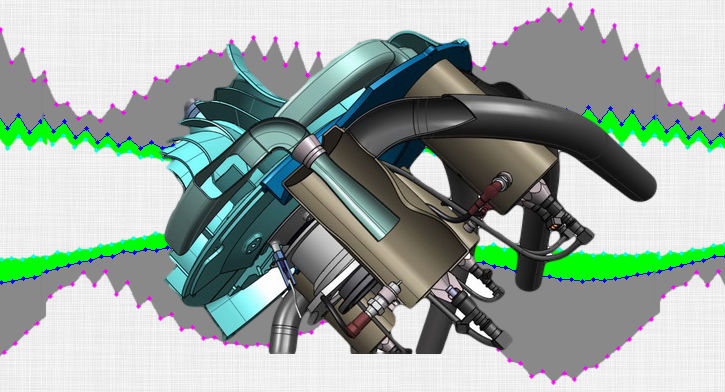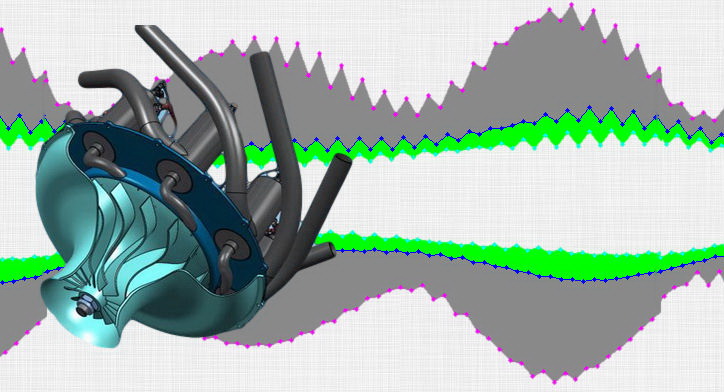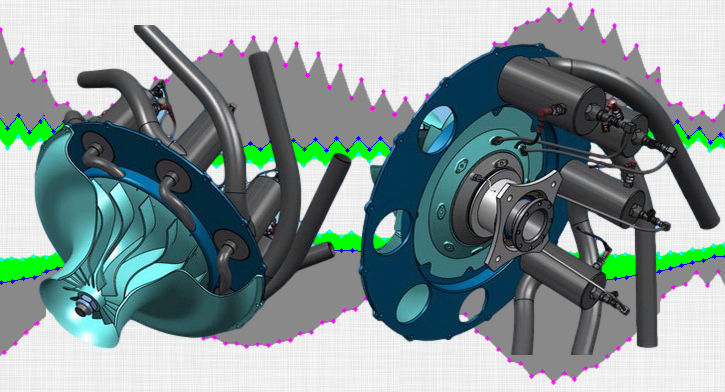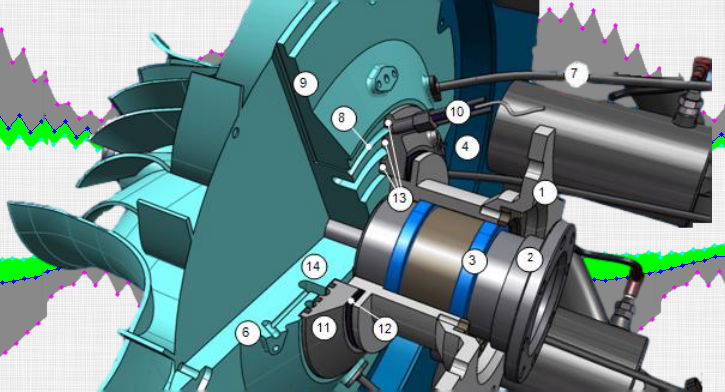The proposed project aims at designing,
manufacturing and building of a demonstrator for a new engine
concept.
The new concept replaces the usual turbine of a classical
turboengine by a number of Pulse Detonation
Combustors (PDC) placed on a disk that rotates under the tangential
impulse provided by the exhaust jet of the
PDC. The rotating disk is coupled, through a shaft, to the
compressor that is placed upstream of the PDC in order
to raise its inlet pressure. Two solutions will be considered for
the engine propulsion: a propeller, coupled, via a
gearbox, to the PDC shaft, or by using the reactive thrust of the
PDC exhaust jet, directed at an optimal angle.
The PDC inlet with be equipped with aerodynamic valves that control
the air entrance into the PDC, thus allowing
a significant increase in the detonation frequency, allowing for
noise reduction and reduced dimensions.
The
demonstrator, consisting of a single, fixed, PDC equipped with a
fuel injection and ignition system designed for
the requirements of the engine concept, will be tested on an
experimental facility in order to demonstrate the
PDC capability to provide enough power to meet the requirements of
the compressor, with sufficient reserve
for powering to propel the host aircraft. The project also proposes
the design and numerical simulation of the
engine compressor, adapted to the requirements of the new engine,
most importantly the high vibration load
and oscillatory back pressure under which the compressor operates.
A
last objective of the project is to provide
a full definition of the engine constructive solution and a
numerical simulation of the flow through the engine
that will allow the estimation of the engine performances. The new
emerging technology is expected to provide
a significant increase in the engine's thermodynamic cycle maximum
temperature and efficiency, a drastic
reduction in its weight and specific fuel consumption, and a
decrease of greenhouse gas emissions.
Main idea:
replacement of gas turbine by simpler system
Advantages:
Reduction in engine weight;
Removal of cycle maximum temperature limitation
Reduction of engine complexity: more reliability, lower costs,
shorter manufacturing time
Reduction of engine size, particularly length
Operating principle:
Multiple rotating pulsed detonating combustors1.png)
Tangential exhaust of combustor flue gases to rotate entire
combustor assembly;
Remaining energy used to power aircraft, by:
- Propeller (turboprop),
- Re-axialization of flow exhaust nozzle (turbojet)
- Controlled direction of combustor exhaust
* tangential velocity component drives compressor and
rotating combustor assembly
* axial component provides thrust by means of exhaust nozzle
FUEL SYSTEM DIAGRAM
- Fuel enters through channel 4 into
stuffing box 11;3.png)
- From here, enters rotor through circular channel 14;
- Enters combustors through electronically controlled
injectors
through channels 6 and pipes 7
- Pressure signal transmitted through circular channel 8
to pressure
transducer 10 that controls injectors
-
Sealing of circular fuel channel and pressure channel ensured by stuffing box 11,
placed between bearing casing 1 and rotor;
-
Stuffing box guided by slide bars preventing its rotation with respect to casing 1,
while allowing axial movement;
-
Sealing pressure force provided by two conical springs by means of graphite rings 13
IGNITION SYSTEM
- Induction coil mounted on the
rotor above exit of channels;
- Coil, as well as the fuel injectors, controlled by means of mobile
brush contacts
STATE OF THE ART
Detonation process studied intensely in the
last century;
First observed in gaseous fuels by Bertolet in 1881, later, Chapman
and Jouguet discovered that detonation products propagate at sonic
speed relative to the detonation wave.
One of the first detonation theories was the one-dimensional,
detonation wave propagation theory of Chapman – Jouguet in 1905 -
1906
Interest increased significantly with the first steps towards
supersonic flight, in the mid-XX century
Various thermodynamic cycles aiming at modeling the detonation
powered engine were developed: Humphrey cycle, ZDN (Zeldovich–von
Neumann–Doring) cycle Fickett-Jacobs cycle.
During the space race, in the ’70, new types of detonation based
thrusters were studied.
Over the last decade, the number of theoretical, experimental and
numerical studies increased significantly.
The practical application of detonation waves in propulsion system
dates back to the 1940s but the complexity of the problem delayed
the first successful demonstrator flight to as late as 2008 (DARPA's
Blackswift).
The demonstration flight was, however, at low speed, and the project
was soon cancelled.
During this time, a significant number of constructive solutions and
approaches has been proposed, however none completely successful,
only as far as prototypes.
EXISTING CONSTRUCTIVE SOLUTIONS
|
|
|
EXPECTED PROGRESS
Fuel supply system
Needs to provide fuel in close correlation with the PDC operating
frequency.
Continuous supply through the disk supporting the rotating PDCs.
The disk will also include the ignition system.
Has the advantage of providing sufficient space to premix the air
and fuel.
To achieve vaporization and possibly preheating in the case of
liquid fuels.
By monitoring the pressure inside the combustor, feedback signal can
be provided to ensure the correct synchronization.
Initiation of detonation wave
Strongly dependent on the inlet conditions.
Use of very energetic spark, deflagration-to-detonation transition,
or shock wave ignition.
Geometry of the PDE exit nozzle
To increase overall engine efficiency combustors must provide the
highest possible impulse on a direction other than along the
combustor axis, the optimal direction with respect to the engine
performances and constructive solution, as well as the minimization
of pressure losses due to the deflection of the flow have to be
studied.
The addition of ejectors on the PDC nozzle should also be
considered.
PDC flow path
Critical for the optimal detonation wave travel.
Stability and completeness of the supersonic combustion, strongly
dependent on the combustor geometry, must also be optimized.
Of special interest is the production and emission of NOx. The high
temperatures in the PDC favors the NOx production, while the very
short residence time in the combustor will tend to decrease the
effect, hence a quantitative approach will have to be used to
determine NOx emissions.
Supersonic combustion models for finite rate kinetics numerical
simulations, as well as the limitations of the existing models
applied to detonations are still an open research topic.
Optimal compressor geometry
Rotation of the downstream combustor.
Discontinuous discharge of the combustor shroud.
A high frequency PDC will alleviate the problem, but the effect on
compressor stability remains to be assessed.
Furthermore, since the combustion process is supersonic, the need to
decelerate the flow upstream of the combustor disappears.
Therefore, the presence of the compressor stator vanes may no longer
be required, thus reducing the pressure losses during the passage
between the rotating and fixed blading.
The noise generated
The effect of opposite phase pairs of PDCs and the optimal
interference of the resulting sound waves needs to be investigated.
Also, the presence of detonation waves inside PDCs raises questions
on the vibration levels of the new engine, which need further
evaluation, understanding and solution finding.
Optimal fuel selection
To allow the reliable initiation of the detonation wave, is also an
open research field.
Most of the research studies carried out up to the present focus on
gaseous fuels.
Experimental studies conducted on PDCs using liquid fuels (kerosene)
have been reported in recent years.
The main problems when considering liquid fuels for PDC are the
increased difficulty to initiate the detonation and the required
very high mixing velocity of the air and fuel to be supplied to the
combustor.
The specific fuel consumption
Lower than in the case of a PJE.
By reducing the overall engine weight, optimizing the supersonic
combustion process, and maximizing the engine power, the overall
fuel consumption can be further minimize.
Novel materials
Able to withstand the high temperatures in the PDC, together with
the mechanical solicitations (mainly centrifugal load and
vibrations) to bring the engine concept from a breakthrough
technology to a market ready product.
PROJECT OBJECTIVES
- Given the complexity of the task, and the
limited resources, the its scope is limited and does not try to
tackle all the problems raised by the new engine concept.
- Instead, the main goal of the project is to prove the
functionality and feasibility of the concept, opening the road
towards developing a mature technology over the next 50 years.
- The most important result expected from the proposed project is to
demonstrate, both numerically and experimentally, that the power
provided by the rotating PDCs can provide the energy to accelerate
the compressor to the speed required for its design performance,
with sufficient excess energy to power up the aircraft.
- A second achievement is expected to be the practical realization
of a high frequency, self supporting ignition PDC.
Combustor inlet will be valve free, and the solution selected to
control the inlet must be proven to prevent the detonation wave to
propagate upstream. A high frequency PDC is expected to be compact,
both in diameter and in length, allowing significant reduction in
engine dimensions and weight.
- The constant volume cycle is of higher efficiency than the
classical Brayton cycle. Due to the elimination of the classical
engine turbine, the maximum temperature limitation will be removed,
thus allowing an overall increase in the engine performance and
efficiency. The project aims at demonstrating the increase in
theoretical cycle efficiency.
- Finally, the project will provide an integrated solution for the
proposed concept, validated through numerical simulation, and laying
the foundation for building a demonstrator engine concept in the
future.






